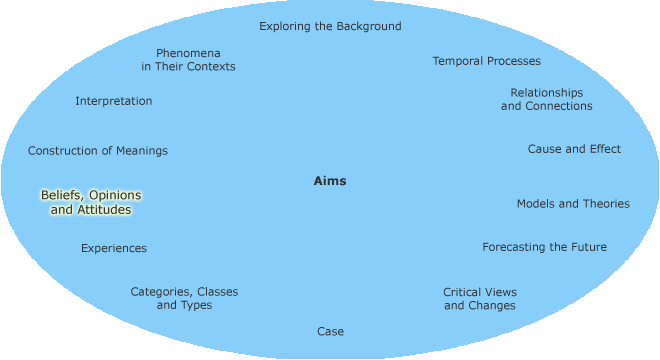Beliefs, Opinions and Attitudes

Humanistic research often aims to describe and analyze people's various points of view, beliefs, opinions, notions and attitudes. Humanistic researchers typically argue that people have different beliefs and opinions on objects and phenomena. They also argue that defining which beliefs are right and which are wrong is sometimes impossible. Humanistic researchers often use the starting point that people's attitudes influence their actions, interpretations and notions. The research aim is often focused on describing and analysing the variety and diversity of beliefs, opinions and attitudes on an object or phenomenon, and on the exploring the motives, causes and effects of the variety of attitudes and opinions. The research may focus on history of attitudes and opinions or on their change at a particular period of time. You must acknowledge your own beliefs, opinions and attitudes towards the researched phenomenon.
Research focusing on the reception of works of art, texts or other phenomena, is a reception study. A reception study may focus on beliefs, opinions and attitudes formed in the reception process.
Strategies
Research aiming to analyse beliefs, opinions and attitudes by exploring concrete materials such as documents, interviews, images or objects, can be defined as empirical research. You can use either qualitative research or quantitative research.
You can also use other research strategies:
A case study enables you to research beliefs, opinions and attitudes by focusing on either a particular or small group of research objects.
Longitudinal research enables you to explore beliefs, opinions or attitudes of some phenomenon over a long period of time.
Discursive approaches enable you to explore the construction and linguistic formation of beliefs, opinions and attitudes.
Cross-sectional research enables you to explore beliefs, opinions and attitudes in different areas of culture and society at a certain point in time.
Data Collection
When your research aim is to analyze the variety of beliefs, opinions and attitudes, you can use different types of data collected by a variety of methods. You can use either data collected for previous research by another researcher (existing concrete materials) or collect / produce your own data during the research process.
You can use a variety of research strategies: Population research is suitable when the quantity of available data on a phenomenon is small. Sampling is suitable when the quantity of available data on a phenomenon is too large for you to analyse all of it. Random sampling enables you to select a small element without bias. Purposive sampling (goal-directed sampling) enables you to select samples that match the aim of the study.
You can collect data, for example, through interviews, questionnaires or follow-up studies, as well as narratives or archival materials.
Data Analysis
Both quantitative analysis and qualitative analysis methods are suitable for analysing beliefs, opinions and attitudes.
Possible analysis methods are:
Phenomenographical analysis enables you to explore the diversity, changes and hierarchies of notions.
Close reading enables you make a general in-depth analysis.
Hermeneutic analysis enables you to make a general in-depth analysis.
Surveys and questionnaires are often analysed using quantitative analysis methods, such as descriptive statistical analysis and correlation and covariance analysis.
Philosophies in Science
Qualitative analysis methods in the humanities are based on interpretivism. Views emphasising interpretation in the formation of meanings and subjectivity in meaning-making processes, obey the idea of relativism.
Hermeneutic analysis is based on hermeneutics.
Close reading methods are based on hermeneutics.
Phenomenological analysis: variations are based on either hermeneutics or more directly on phenomenology.
Discourse analysis: Variations may be based on constructivism.
Conversation analysis: Variations may be based on constructivism.
Social constructionism, which views knowledge, reality and the phenomena as being constructed in social interaction is the basis of research into the meaning of language in the production of attitudes and notions.
Quantitative analysis methods are based on positivism, which stresses the production of knowledge through exact measurements and use of numeric variables. Views emphasising the exactness and correctness of measured knowledge are based on realism, which views knowledge as objective.
Research examples in exploring beliefs, opinions and attitudes are available in:
